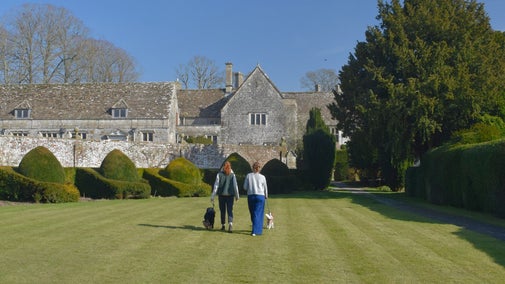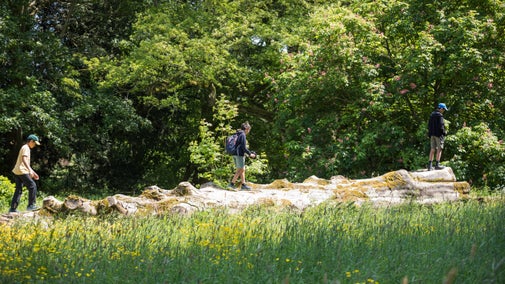
Discover more at Avebury
Find out when Avebury is open, how to get here, the things to see and do and more.

Recognised as a World Heritage Site for its outstanding Neolithic and Bronze Age monuments, Avebury stone circles and henge are full of traces of our ancient past. The surrounding landscape also includes including a stone-lined avenue and the largest artificial mound in Europe.
As in previous years, access to all four henge banks is closed in January. The closures are done each year at this time to help protect the earthworks during wet, winter weather, however access to the rest of the monument and stone circles will remain open as usual. We are aiming to reopen access to the SE henge bank on Saturday 31 January.
Avebury Henge dates from around 4,600 years ago. The bank and ditch are almost a mile in circumference, and the ditch was originally around nine metres deep. The banks were built up from chalk, dug from the ditch using stone and bone tools, and both would have been bright white when new.
The outer stone circle is the largest prehistoric circle of standing stones in the world and there are the remains of two other smaller stone circles within it.
The stones are huge with the largest weighing at least 100 tonnes, making it the heaviest in Britain. The stones are a locally sourced hard grey sandstone known as sarsen. You can walk amongst all the stones and along the henge bank.
Look out for the tallest stone at The Cove in the north-east section of the henge. Roads are situated through the circle with gates at each location to contain the sheep that graze the land.
Some areas of the stone circle have steps and uneven terrain and we advise visitors to wear appropriate footwear, particularly during or after wet weather.
If you'd like to learn more about the prehistory of Avebury and the people who built the henge and stone circles, then join a stone circle tour.
These guided tours are led by knowledgeable volunteers, run most days, and take approximately an hour.
You can book a place at the Visitor Reception desk in the Great Barn when you arrive.

An avenue of paired standing stones that originally wound through the landscape connecting Avebury Henge at one end with a site known as The Sanctuary at the other.
When new, there were probably around 100 pairs of standing stones, with each pair arranged roughly 20-30m from the next pair.
Today, the stones remain standing for the first 800m leading from the stone circle. The avenue walk now provides a link to the field at Waden Hill. If you walk to the top you’ll have clear views across to Silbury Hill.
If you visit at dusk, look out for barn owls that regularly hunt for prey in this area as the fields provide plenty of small mammals for their food.
Silbury Hill is the largest artificial prehistoric mound in Europe, measuring 30m in height. With a modest beginning, it was gradually enlarged to become what we see today.
Excavations in 2007 showed that construction began around 4,400 years ago and may have taken up to 200 years to finish.
It is not known why this structure was built. It is similar to some of the pyramids of Egypt in scale and the effort involved in construction, but unlike the pyramids, Silbury Hill does no’t contain evidence of a burial or that one was ever intended.
Silbury Hill is managed by English Heritage and to prevent further erosion to the mound there’s no access to the hill itself.
A good viewpoint can be found from Waden Hill, which can be reached from the bottom of West Kennet Avenue or from the English Heritage Silbury Hill car park.
West Kennet Long Barrow is a burial mound built around 5,600 years ago. Originally the mound would have been bright white from the chalk used to build it.
Over a thousand years later, access to the chambers was made more difficult with the addition of the large stones blocking the entrance.
Today, you can step beyond the impressive entrance stones to explore inside the tomb (with four lateral chambers and one end chamber) and see where the remains of 36 people were placed when the mound was new, along with grave goods of pottery, beads, stone tools and a dagger.

The Sanctuary probably dates from around 4,500 years ago. It lies at one end of the West Kennet Avenue and is a monument of concentric circles once made from timber and stone.
The low concrete posts mark the original positions of the standing stones and timber uprights.
The Sanctuary is next to the busy A4 road. Please take extra care when pulling out of the lay-by due to the limited view and speed of passing traffic.
Not far from The Sanctuary and also on Overton Hill is a group of Bronze Age burial mounds now known as Seven Barrows.
This is a traditional name and does not reflect the real number, which is greater although many are no longer visible. The remains of a Roman road can also be seen in the same field as the barrows.
Seven Barrows is by the busy A4 road. For your safety, please do not try to cross the road here.
At Windmill Hill, three concentric rings of ditches mark a place where around 5,500 years ago – a thousand years before the stone circles at Avebury were built – people came to spend at least part of each year.
Set away from other features at Avebury, this quieter space was once busy with people gathering here. If you look carefully you can still see the ditches, and several Bronze Age burial mounds dating back around 4,000 years still stand proud in the landscape.
The position in the landscape gives a good vantage point to spot buzzards searching for carrion in the fields surrounding the area.
.

Find out when Avebury is open, how to get here, the things to see and do and more.
Avebury is a two pawprint rated place. With miles of space to explore, dogs love walks at Avebury. Find out where they can go and where to find water bowls and treats.

Find out more about the history of the area including research from two archaeological and geophysical surveys in 2017. Discover new findings at this important site.

The Circles Café serves lunches, cakes, snacks and drinks. Visit the National Trust shop for sustainable products and gifts, or browse Cobblestones second-hand bookshop.

The garden is arranged as a series of 'rooms', each with an individual character. The garden is open all year so you can explore every season. With herbaceous borders, topiary and an orchard, it’s an ideal place to relax.

Discover artefacts from archaeological excavations in the museum. Step inside the large threshing barn and see the 16th-century dovecote near the wildlife pond.

Plan a visit to one of the special countryside places in our care and discover the benefits of being in the great outdoors. Pack your walking boots and get ready to explore woodlands, valleys and rivers.

Wiltshire has a vast amount of countryside to explore including woodlands and trails. Get outside and enjoy the space with your family and friends.

Explore some of the finest landscapes in our care on coastal paths, accessible trails, woodland walks and everything in between. Find the best places to walk near you.
